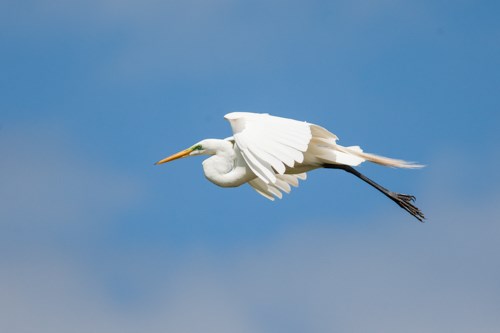
NPS/Gordon Dietzman IntroductionThe great egret, a spectacular large, white bird stalks the quiet waters of large rivers and lakes looking for prey, such as fish, frogs, snakes, and crayfish. These carnivorous birds have special adaptations of long legs for wading and a sharp bill designed for grasping or spearing slippery prey. The great egret’s neck, like all herons, contains a modified vertebrae that gives the bird’s neck its characteristic “S” shape and that provides the bird with a swift stabbing motion. This bird was once hunted for the millinery (hat) trade nearly to the point of extinction by early 1900s. Their spectacular breeding feathers, long flowing plumes originating head, neck and shoulders, literally were worth their weight in gold. Since protection from market hunting in the early 1900s and the ban on DDT in the 1970s (which also affected their populations), this species has recovered. Both members incubate the eggs. Nest exchanges, in which the male and female exchange the incubation responsibilities, contain elaborate greeting ceremonies that reinforce pair bonds. Incubation begins immediately upon the laying of the first egg, but this leads to chicks of different sizes in the same nest. Siblicide, when larger nest mates kill smaller ones, often occurs, especially in years when food is scarce and competition is high. Brood reduction seems harsh, but food resources are concentrated on those remaining nestlings maximizing the number of young that are successfully raised. In good years, there is much less competition and siblicide is much reduced. Parents are either unwilling or unable to interefere when chicks begin fighting. Fascinating Facts
Identification
| |
Last updated: September 28, 2021
